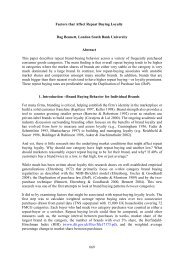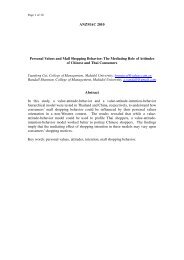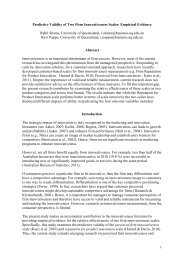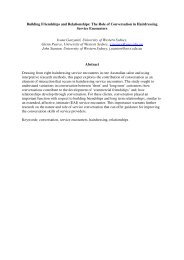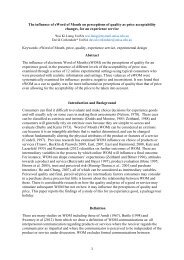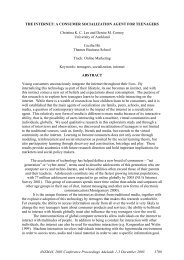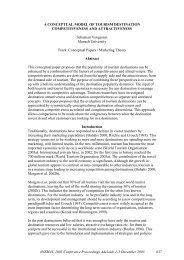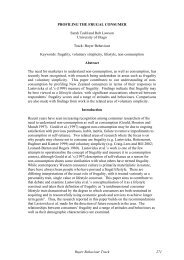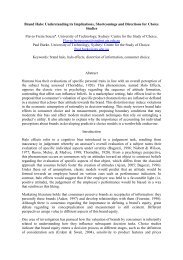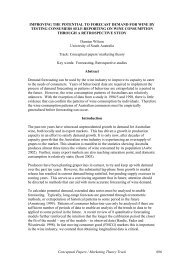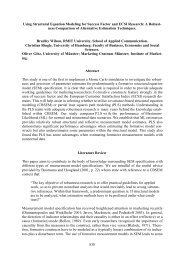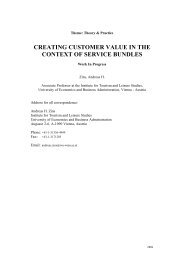amj Australasian Marketing Journal - ANZMAC
amj Australasian Marketing Journal - ANZMAC
amj Australasian Marketing Journal - ANZMAC
Create successful ePaper yourself
Turn your PDF publications into a flip-book with our unique Google optimized e-Paper software.
survey and the main survey. The pilot survey was designed to<br />
create a fully-fledged preliminary sample survey among<br />
different consumers in the Sydney region.<br />
In the main survey the questionnaires were distributed through<br />
mail to the students of an Australian graduate business school.<br />
This follows the practice of past research, Erickson et al.<br />
(1984), Wall and Heslop (1986); and Papadopoulos et al.<br />
(1990) for example, who used students as the respondents.<br />
The students were chosen as subjects of the study because a<br />
high rate of response was expected and due to the ease of<br />
follow-up, and, of course, budget constraints. A recent metaanalysis<br />
by Liefeld (1993) revealed no statistically significant<br />
differences in country-of-origin effect size estimates between<br />
studies involving student (convenience) samples versus (more<br />
representative) consumer samples, a finding largely echoed<br />
by Peterson and Jolibert (1995). Furthermore, as Liefeld<br />
(1993) has noted, this issue becomes less important when the<br />
study involves respondents who have prior experience or at<br />
least some familiarity with the products involved.<br />
The survey questionnaires were distributed to a sample of<br />
1000 students by mail, between November 1997 and March<br />
1998. In total 275 completed questionnaires were received<br />
and among those 248 were considered as useable. Table 2<br />
shows the sample characteristics.<br />
5. Results<br />
The importance of each of the attributes, viz. COA, COD,<br />
brand and price levels, are measured according to the utility<br />
part-worth of the respective attributes. Analysis of variance<br />
(ANOVA) was also performed for each product category to<br />
examine the significance and the impact of the four factors.<br />
5.1 Effects of COA and country of design on evaluation of<br />
product quality:<br />
Figure 1 and Table 3 present findings on the relative importance<br />
of the four attributes in quality judgments as derived<br />
from the conjoint analysis. The results show that, in terms of<br />
the judgement of quality, COA is a more important cue than<br />
COD, price or brand. COD is found to be second most important,<br />
in the quality evaluation of cars, and its effect is higher<br />
than brand and price. However, it is not as important as brand<br />
name in the judgement of the quality of jeans and pineapple.<br />
For these two product categories, brand appears to be the<br />
second most important attribute after COA.<br />
The above results show that the most important factor is COA<br />
for all the product categories. Moreover, the impact of COA<br />
is stronger for low involvement (pineapple) products than for<br />
high or medium involvement products. One of the reasons<br />
could be that the product selected involves a concern for safety<br />
and hygiene.<br />
In the case of cars the results indicate that all the factors independently<br />
influence the judgement of quality. The most<br />
notable result is that COA is found as the most important<br />
Country Design and Assembly<br />
factor influencing the judgement of quality followed by COD,<br />
price and then brand. Though a few significant interactions<br />
were found between these factors (discussed below), in developing<br />
the perception of car quality, the mean square values<br />
can only explain a very small portion of common variance,<br />
suggesting that the interactions are not important. Both the<br />
effects of COA and COD are higher than the effects of brand<br />
and price.<br />
In the case of jeans, all the attributes are found to be important.<br />
It appears that, as in the case of cars, the effect of COA<br />
is the highest in the judgement of the quality of jeans,<br />
followed by brand, COD and price. Moreover, the effect of<br />
brand name is found to be more important than in the case of<br />
judgement of quality of cars.<br />
For tinned pineapple, the results indicate that COA is the most<br />
important factor in the judgement of the quality. Brand was<br />
found to be the second most important factor in the judgement<br />
of the quality of pineapple followed by COD and then price.<br />
Overall, the results reveal that COA is the most important<br />
factor influencing the judgement of quality. Though Chao<br />
(1993) has initiated the concept of the division of country-oforigin<br />
cue into COA and COD, the results from his study did<br />
not show such a strong effect of COA on product quality evaluation.<br />
The present study clearly indicates the importance, for<br />
Australian respondents, of COA across the range of products<br />
studied relative to brand, price and COD, relative to judgements<br />
of quality. However, it should be acknowledged that<br />
actual purchase intentions may not correspond with the<br />
simple evaluation of quality. For example, nationalistic<br />
consumers may still choose locally made products, even<br />
though they may not necessarily feel such products are of a<br />
higher quality.<br />
Table 4 below depicts the analysis of variance (ANOVA)<br />
results for judgements of quality for the three product categories<br />
and, additionally, explores the interaction effects. On<br />
the basis of mean squares and high F value (Keppel, 1982), it<br />
is clear that the COA explains the largest proportion of<br />
common variance across the three product categories. It also<br />
appears that all the other attributes explain a significant<br />
proportion of common variance. It can be concluded that all<br />
these informational cues have significant main effects on the<br />
product quality perception across the three product categories<br />
These results thus provide support for H1 in demonstrating a<br />
significant relationship between, COA, COD, brand and price<br />
in perceptions of product quality.<br />
Whilst there were significant interaction effects for cars, no<br />
such effects were observed for jeans or pineapple, suggesting<br />
that buyers formed clear and independent judgements of the<br />
contribution of each of the independent variables to the overall<br />
judgement of quality. This may be explained by the technical<br />
complexity of cars relative to the complexity of garment<br />
(jeans) and food (pineapple) manufacturing. It may suggest<br />
<strong>Australasian</strong> <strong>Marketing</strong> <strong>Journal</strong> 9 (1), 2001 65



